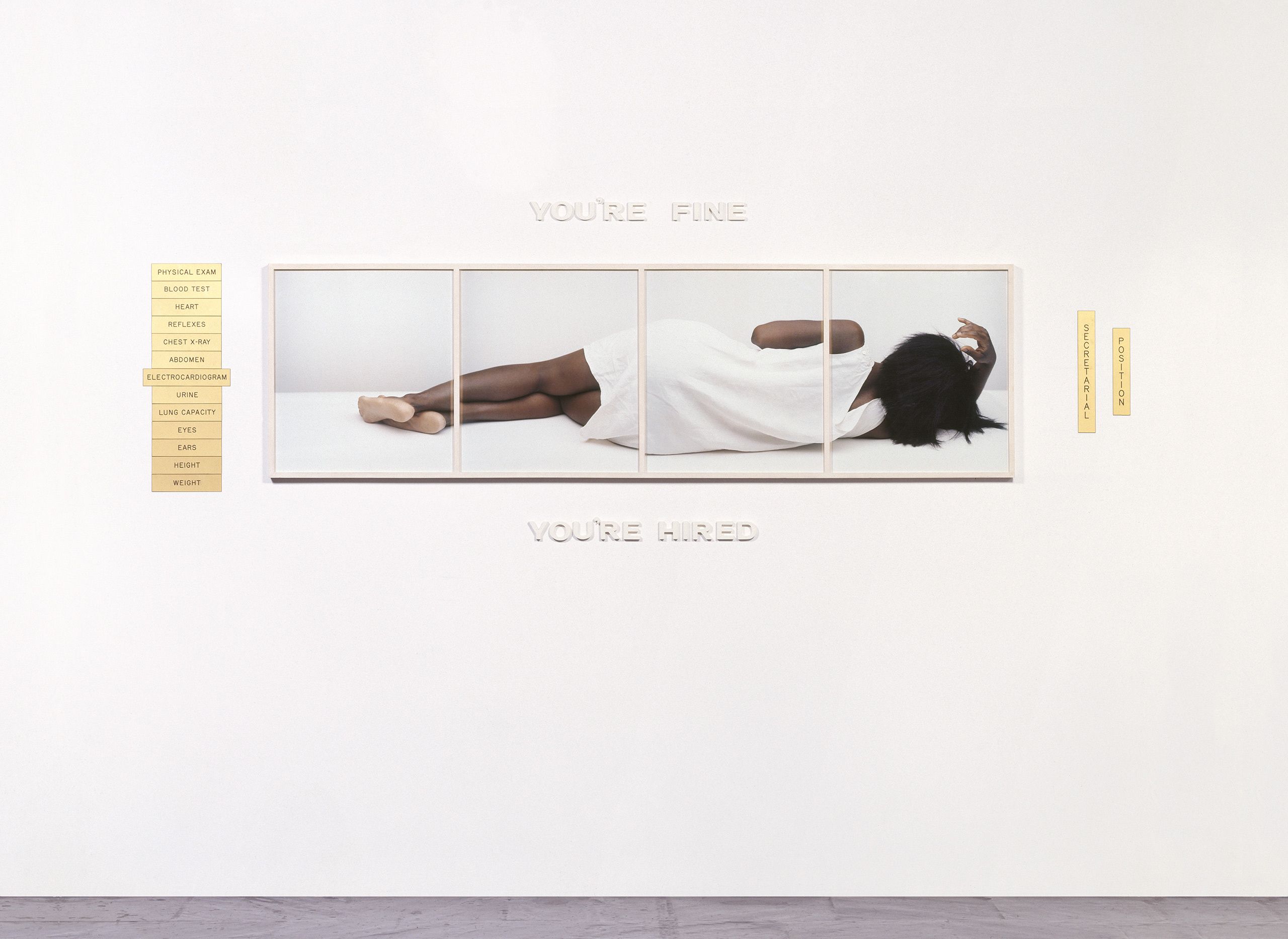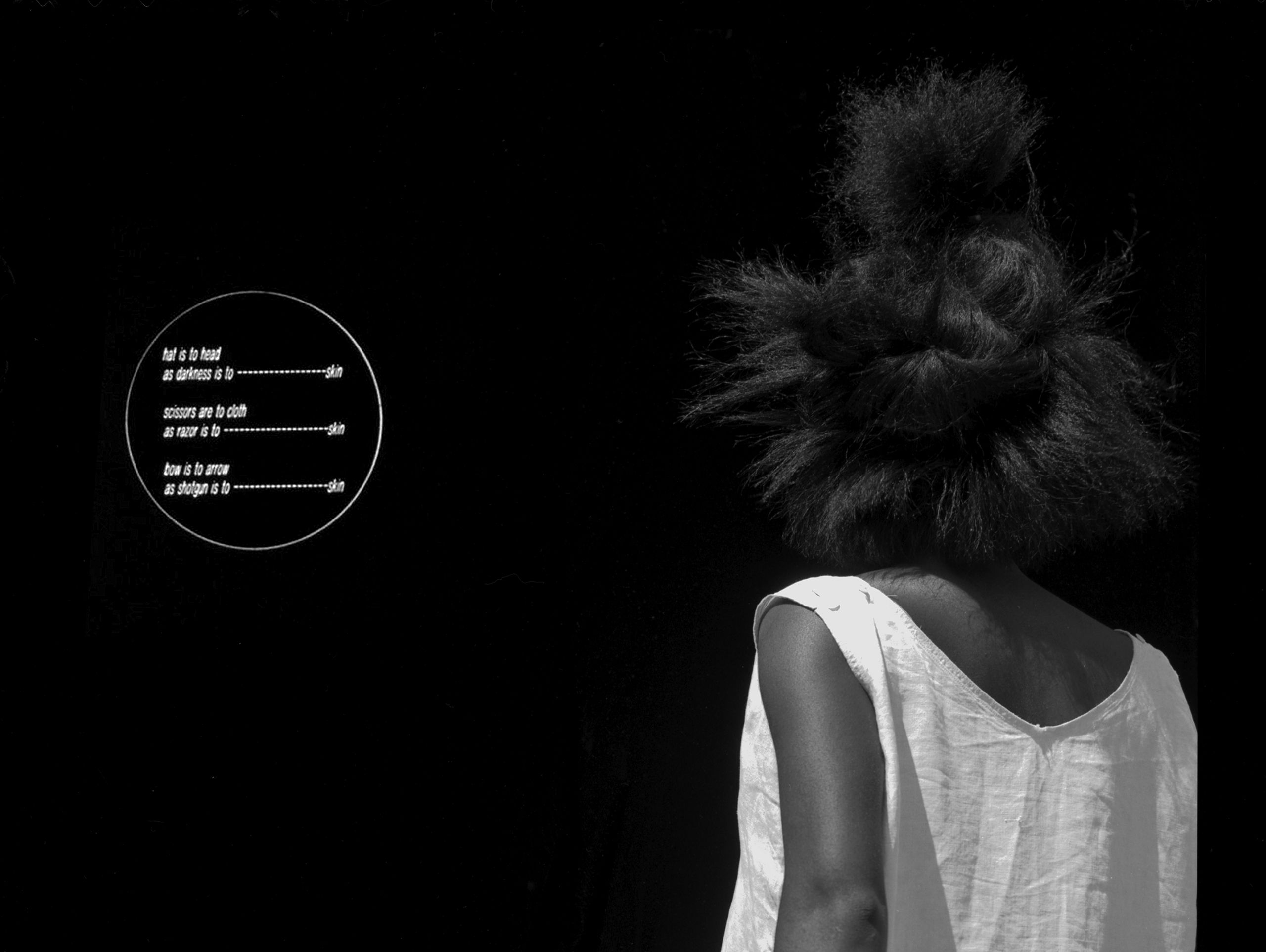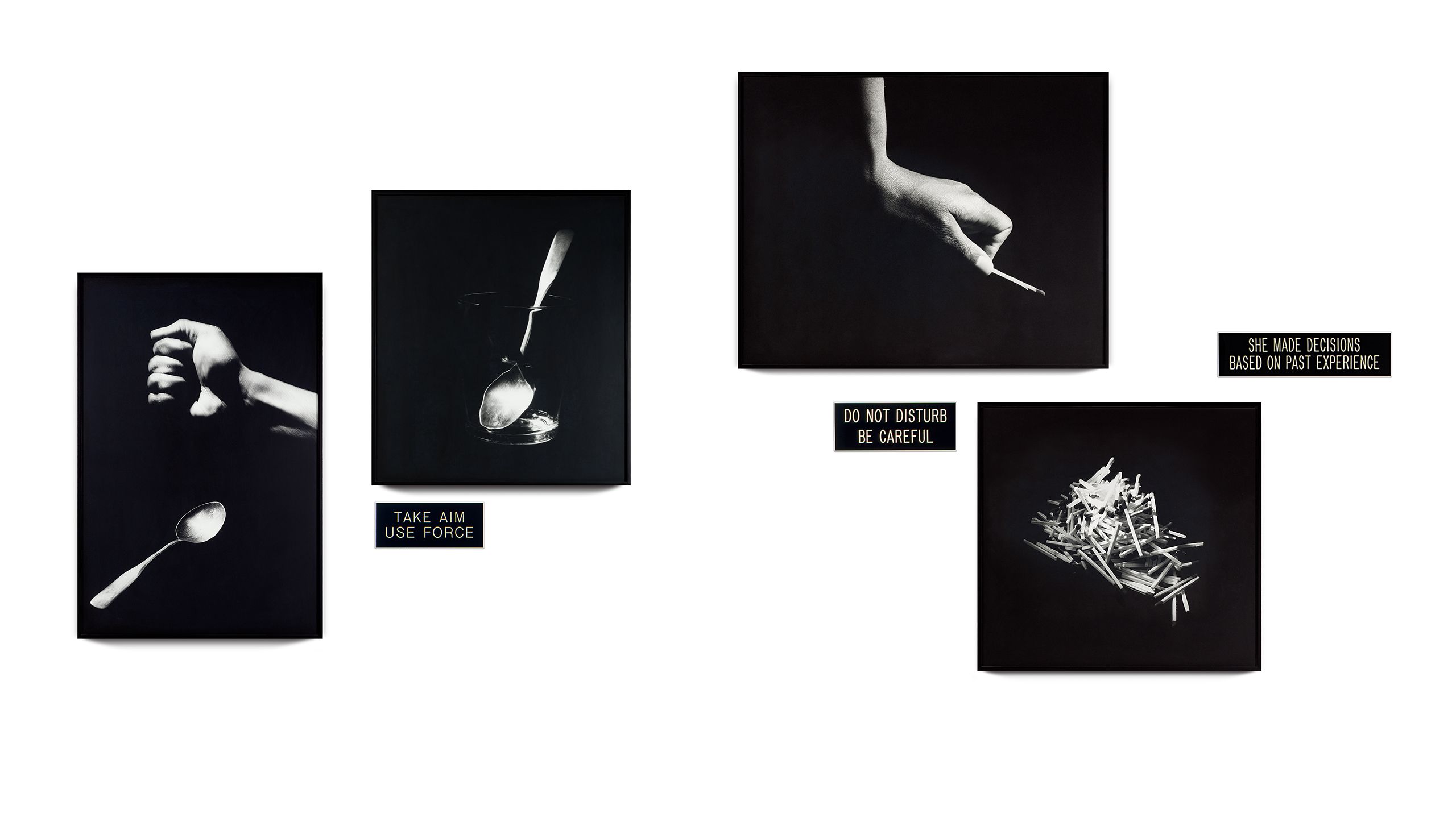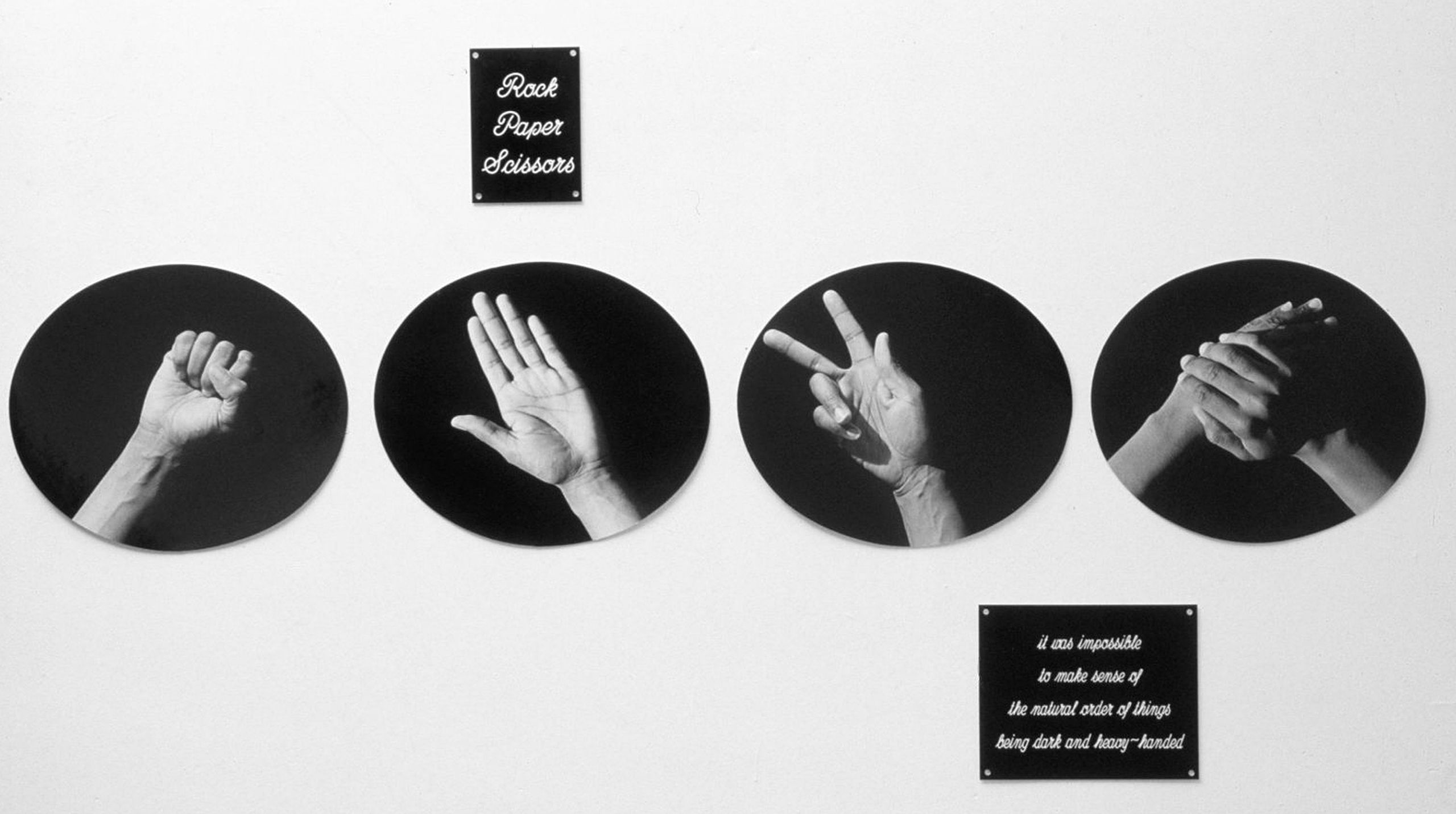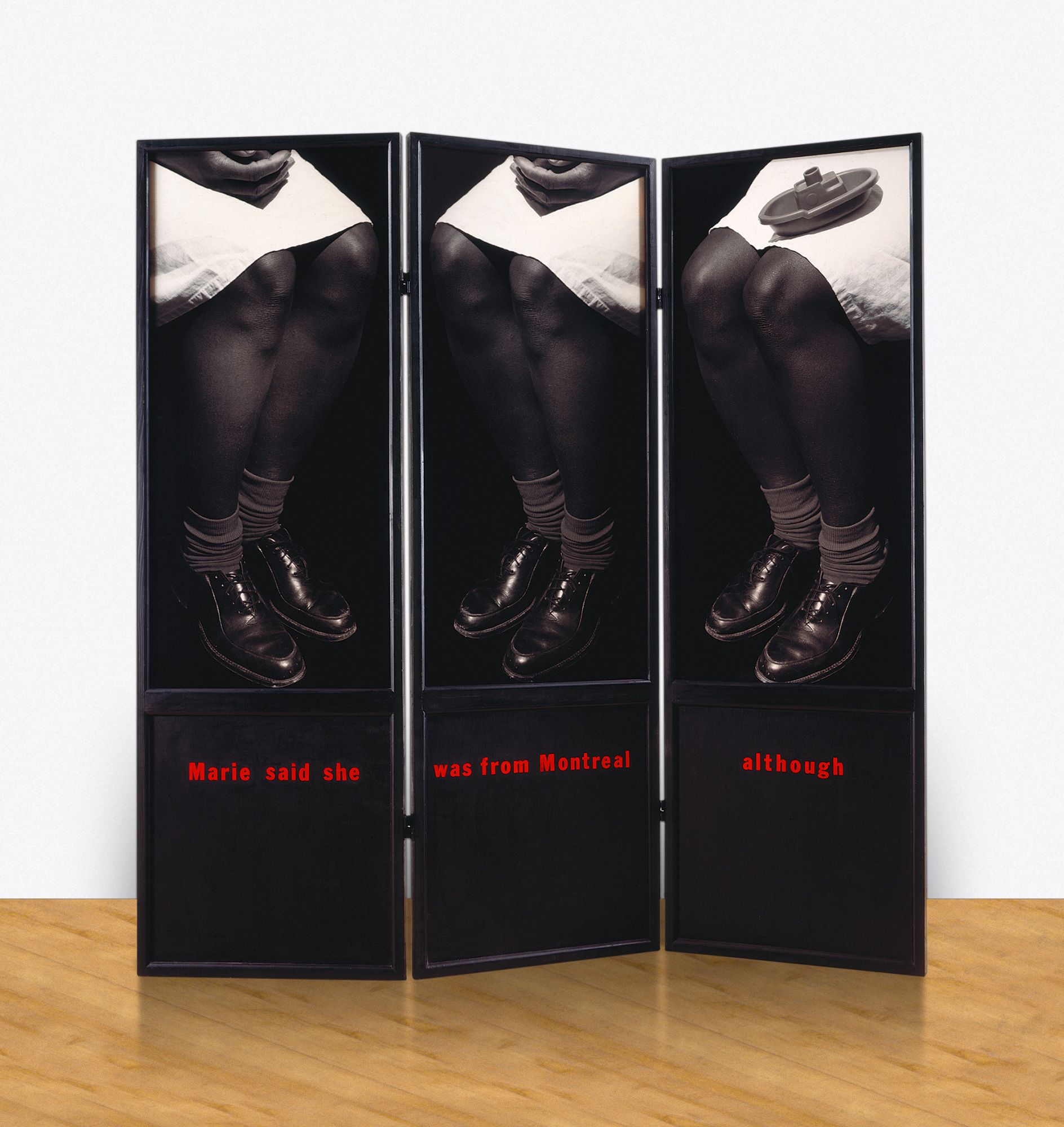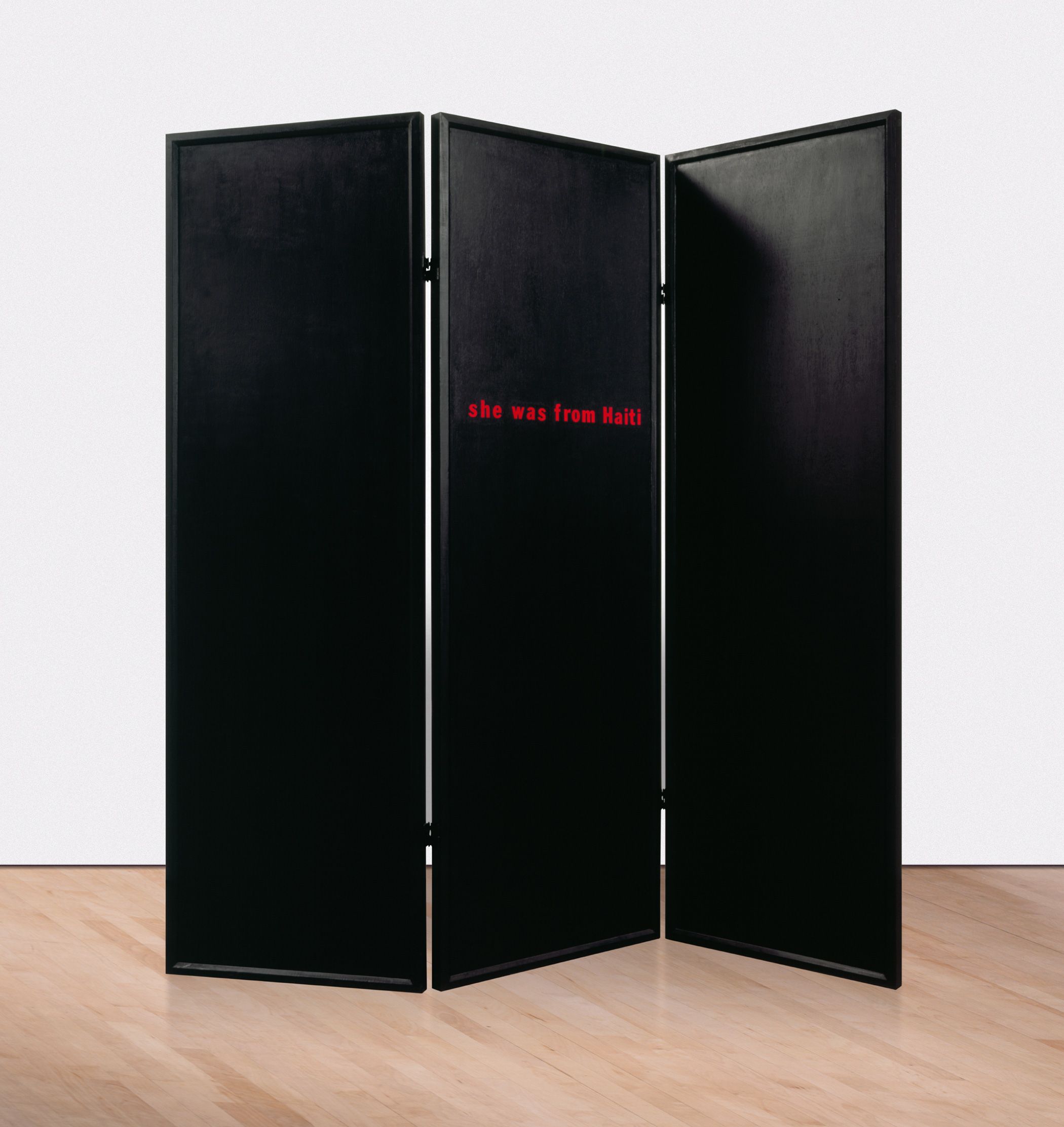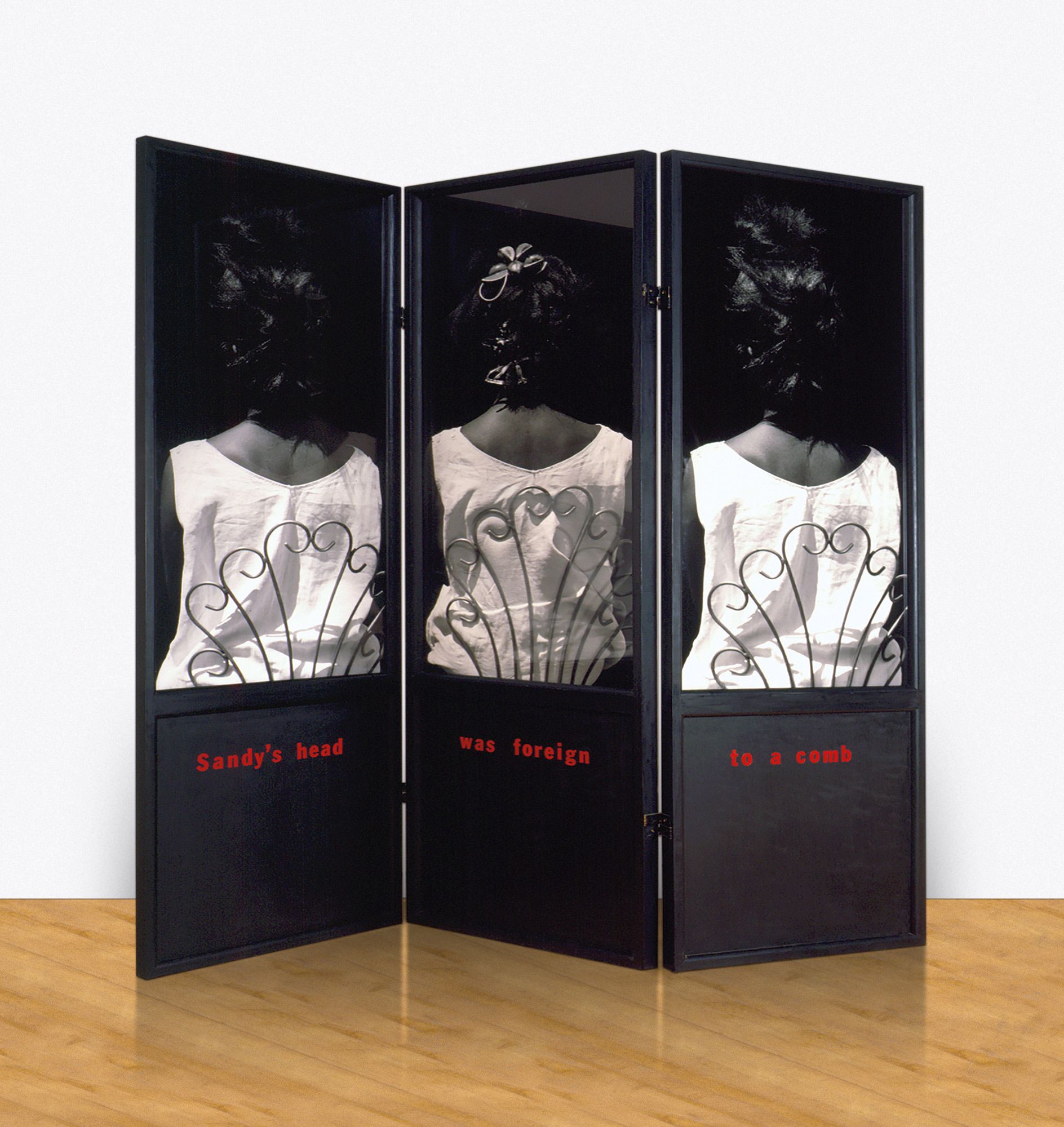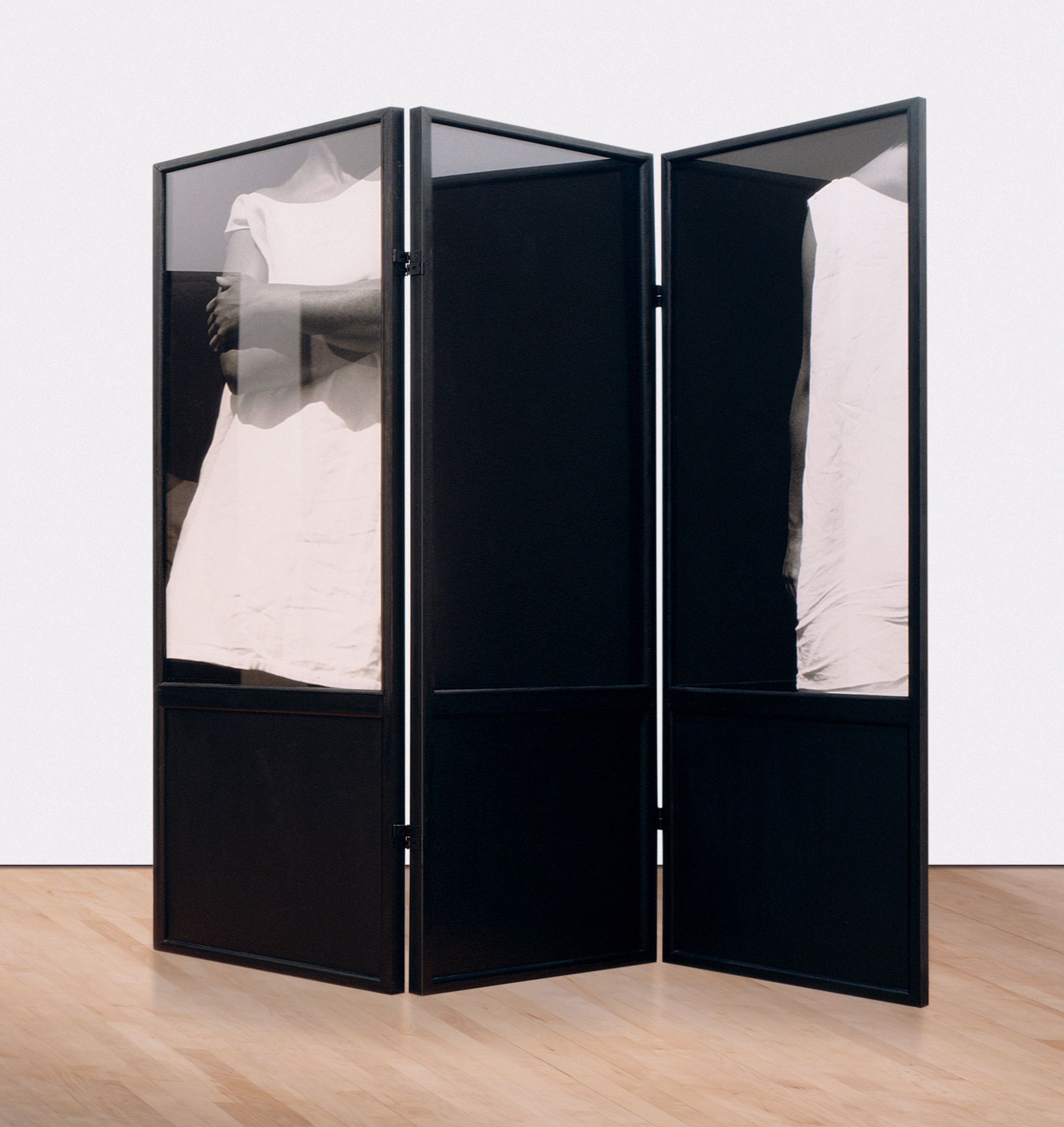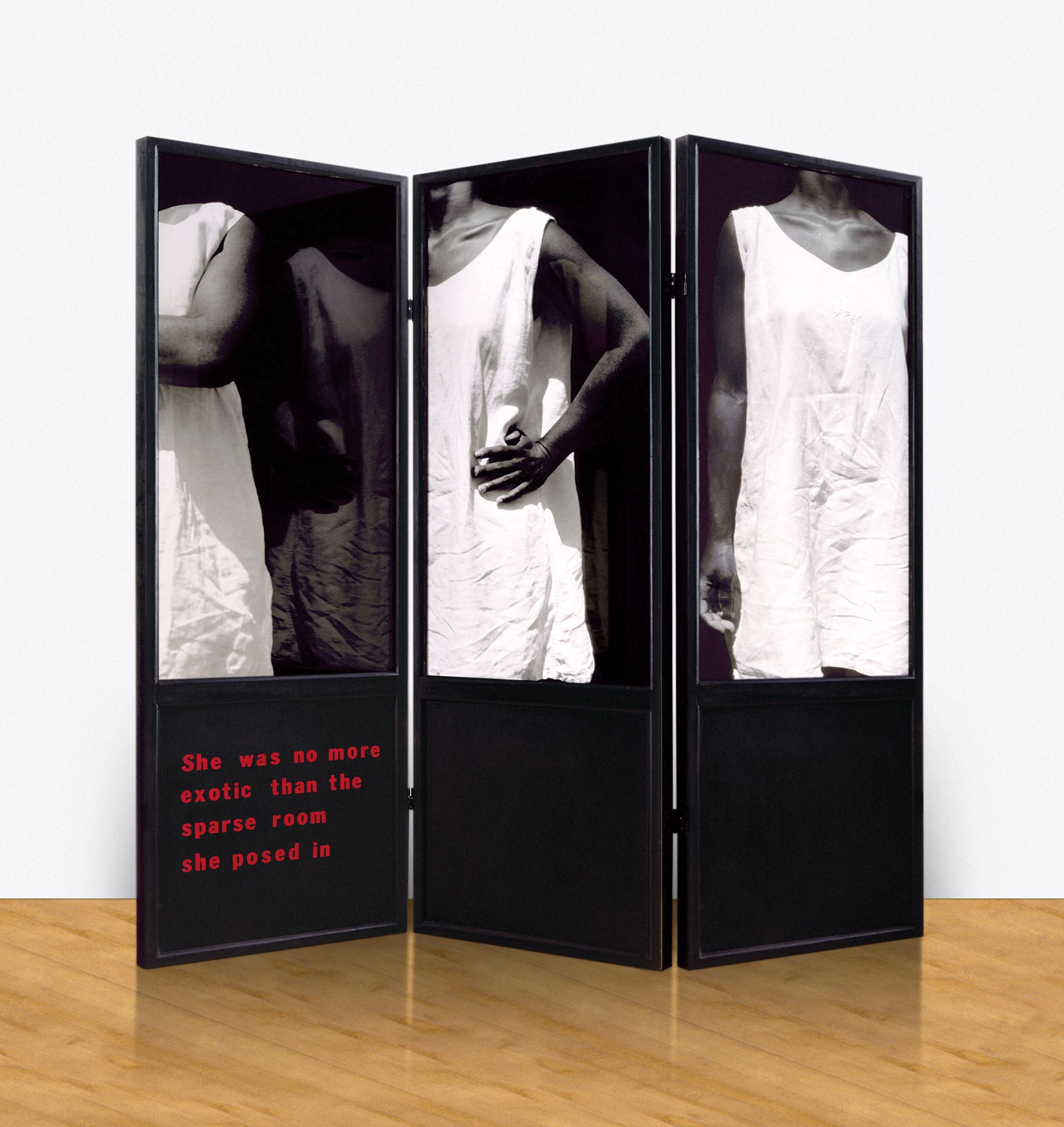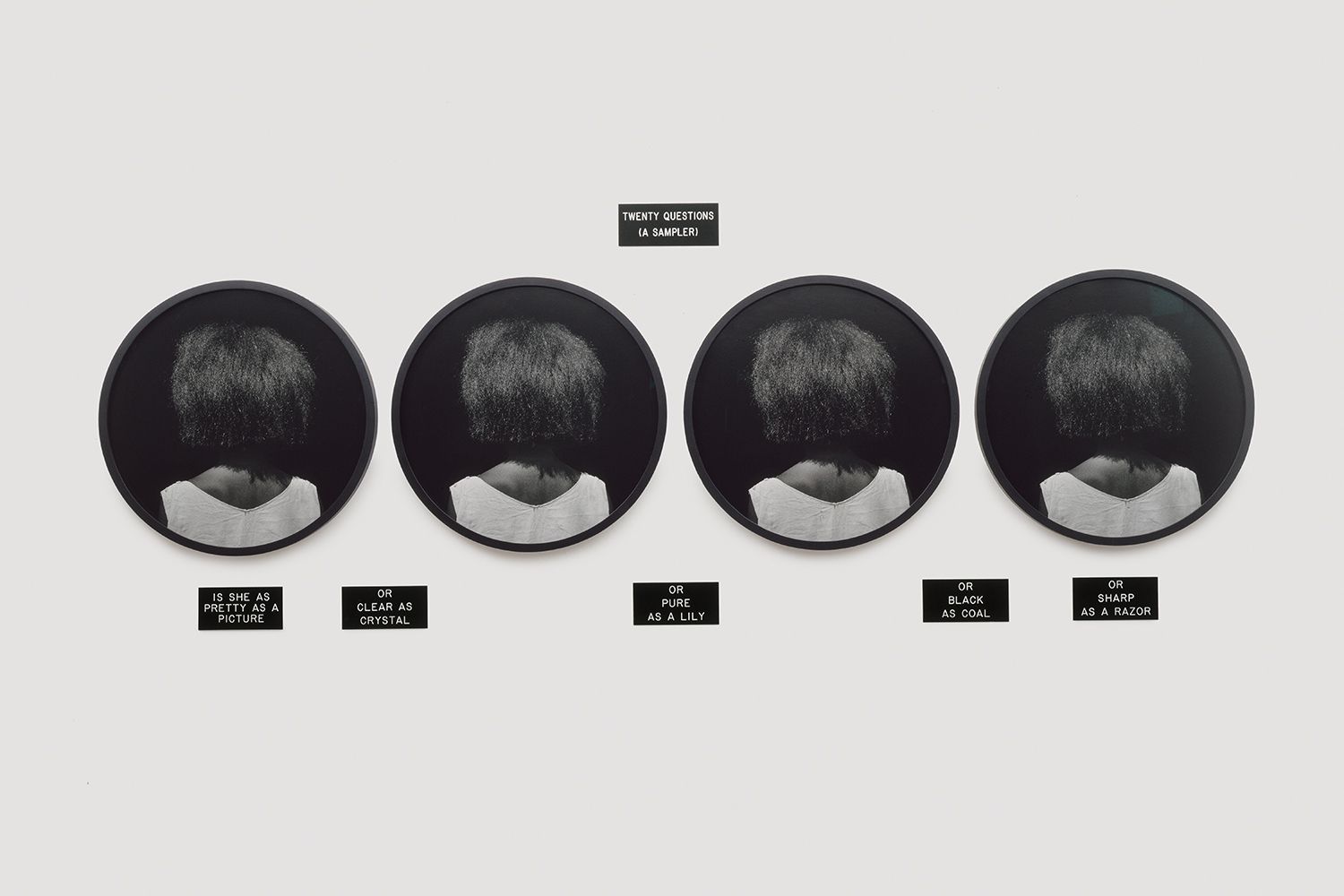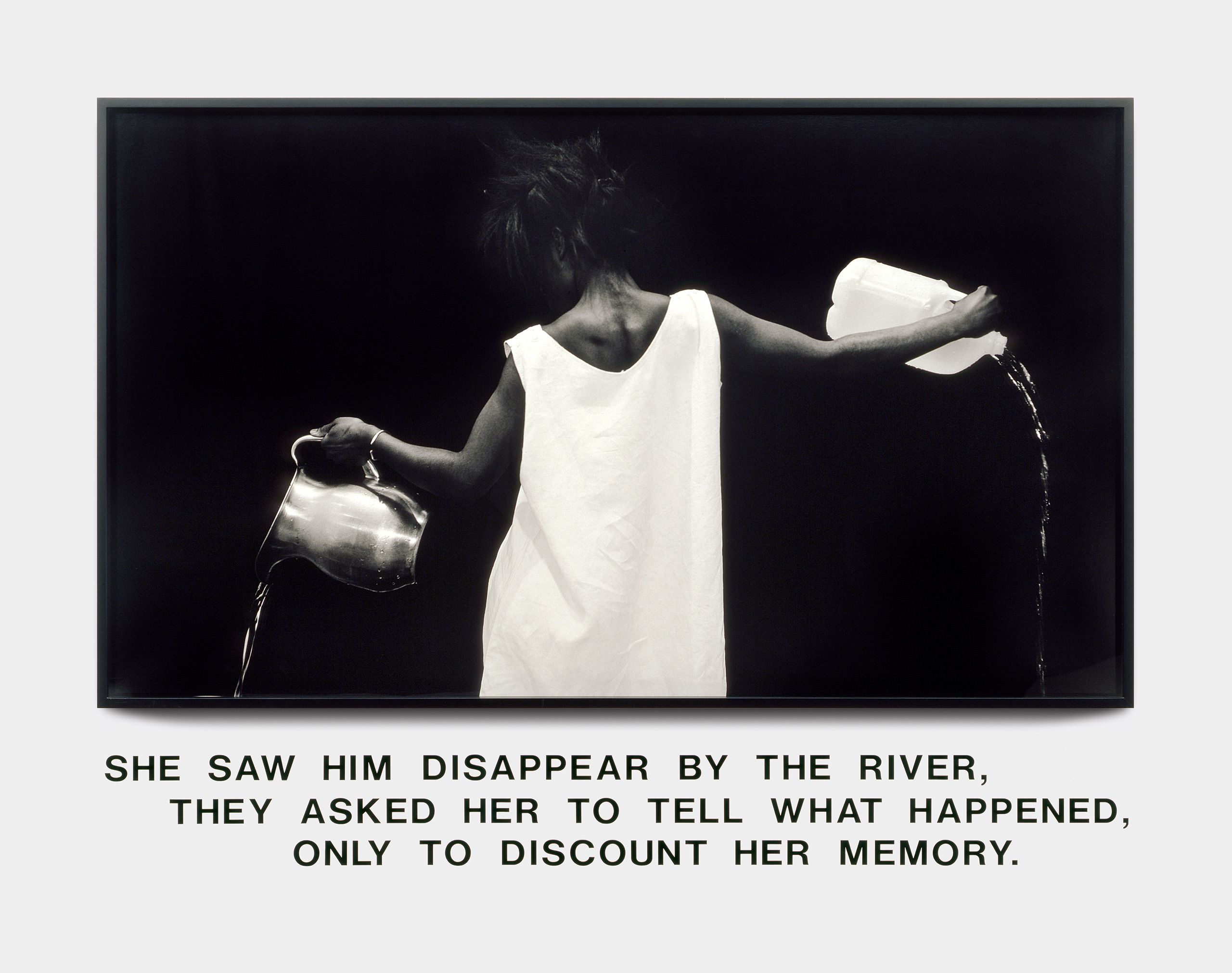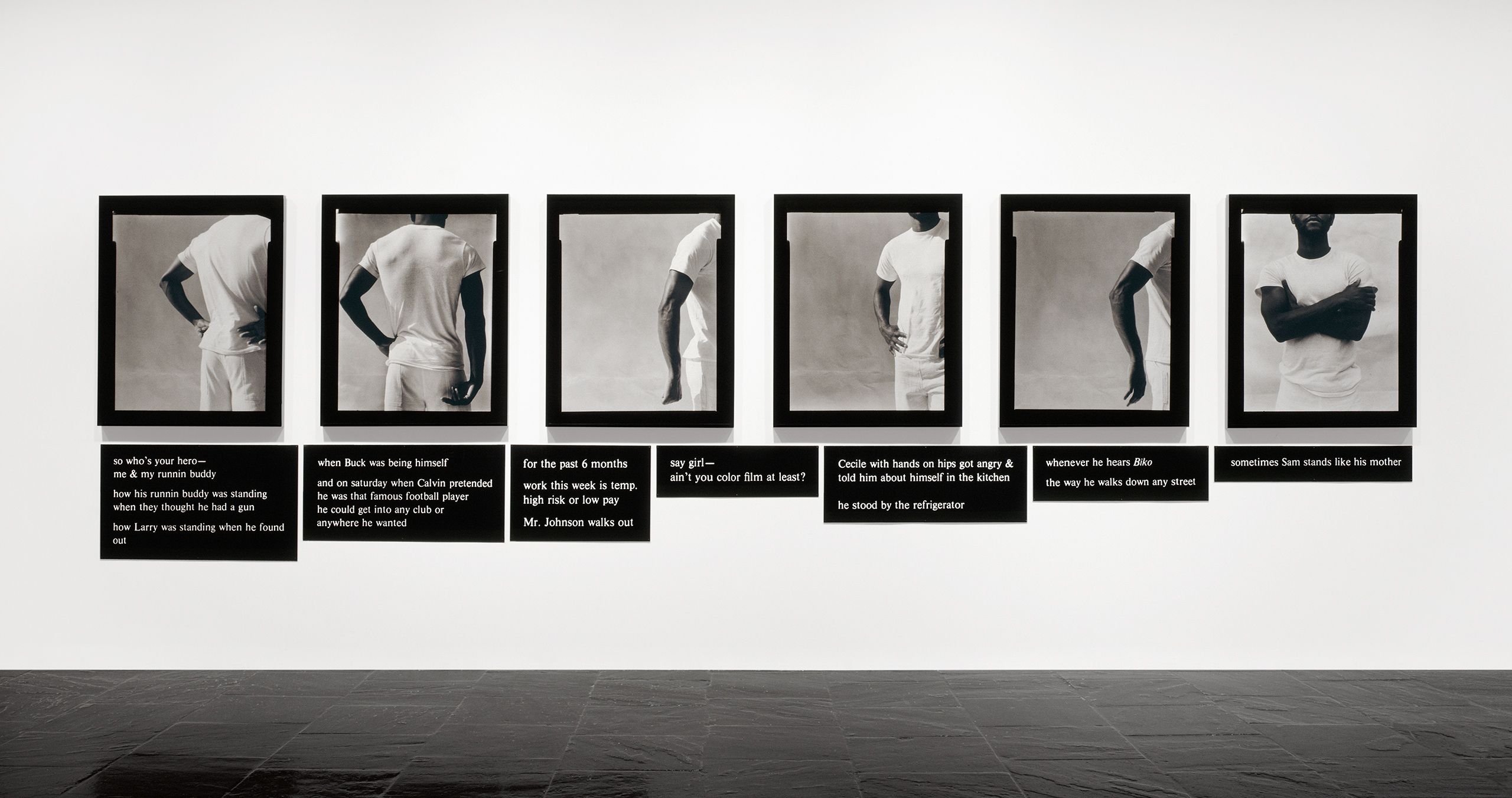1985-88
-
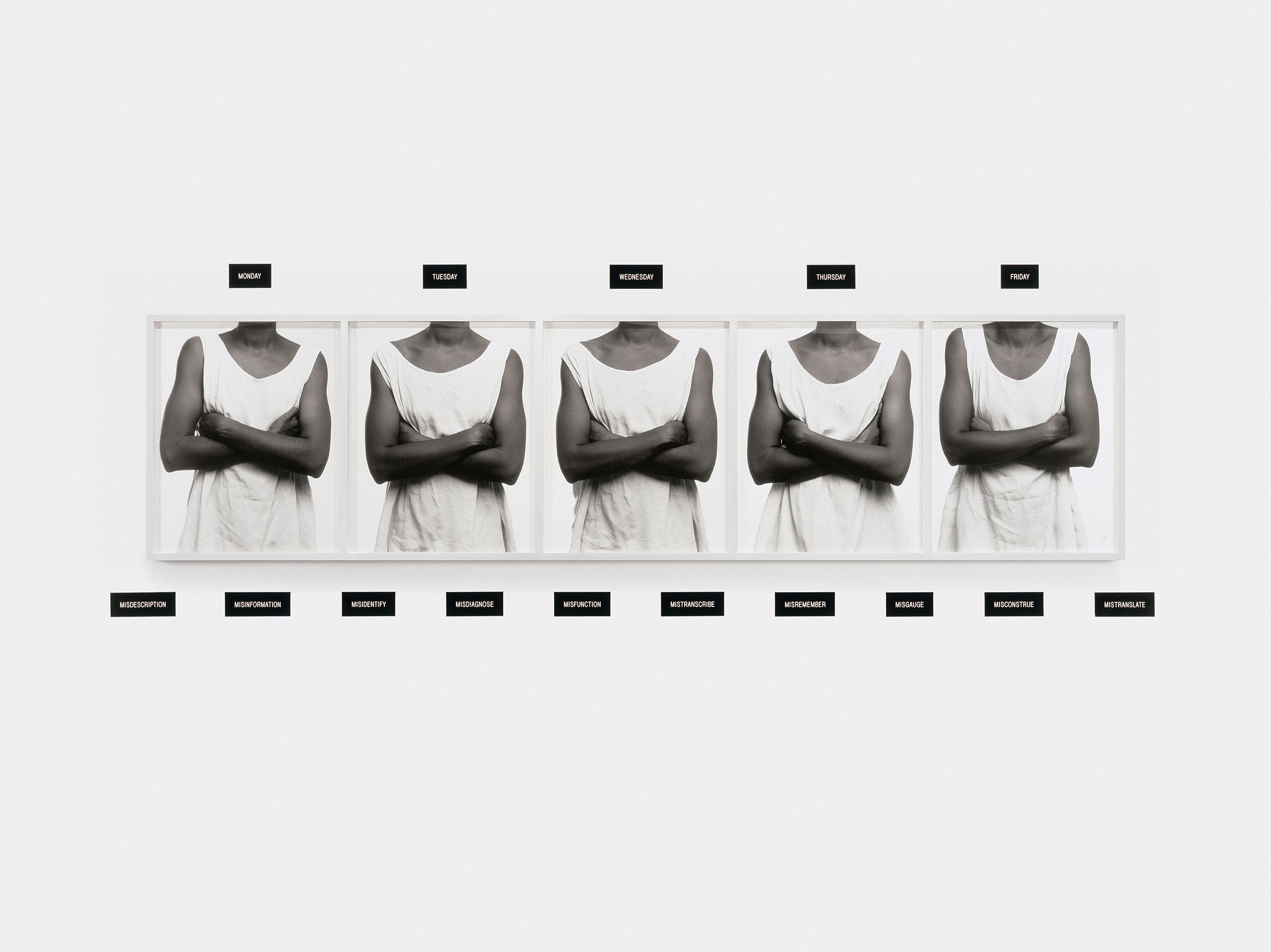
Five Day Forecast, 1988
5 silver gelatin prints, 15 engraved plastic plaques - Overall: 24 1/2 x 97 in (62.2 x 246.4 cm), "Five Day Forecast is typical of Simpson’s work of the mid-1980s, with its formal combination of image and text and examination of the processes through which meaning and understanding take place. In these early works Simpson often used the image of a black woman, photographed cropped, or from behind, against a stark background, and accompanied by text panels. Both text and image are deliberately austere in style." -Rachel Taylor
-
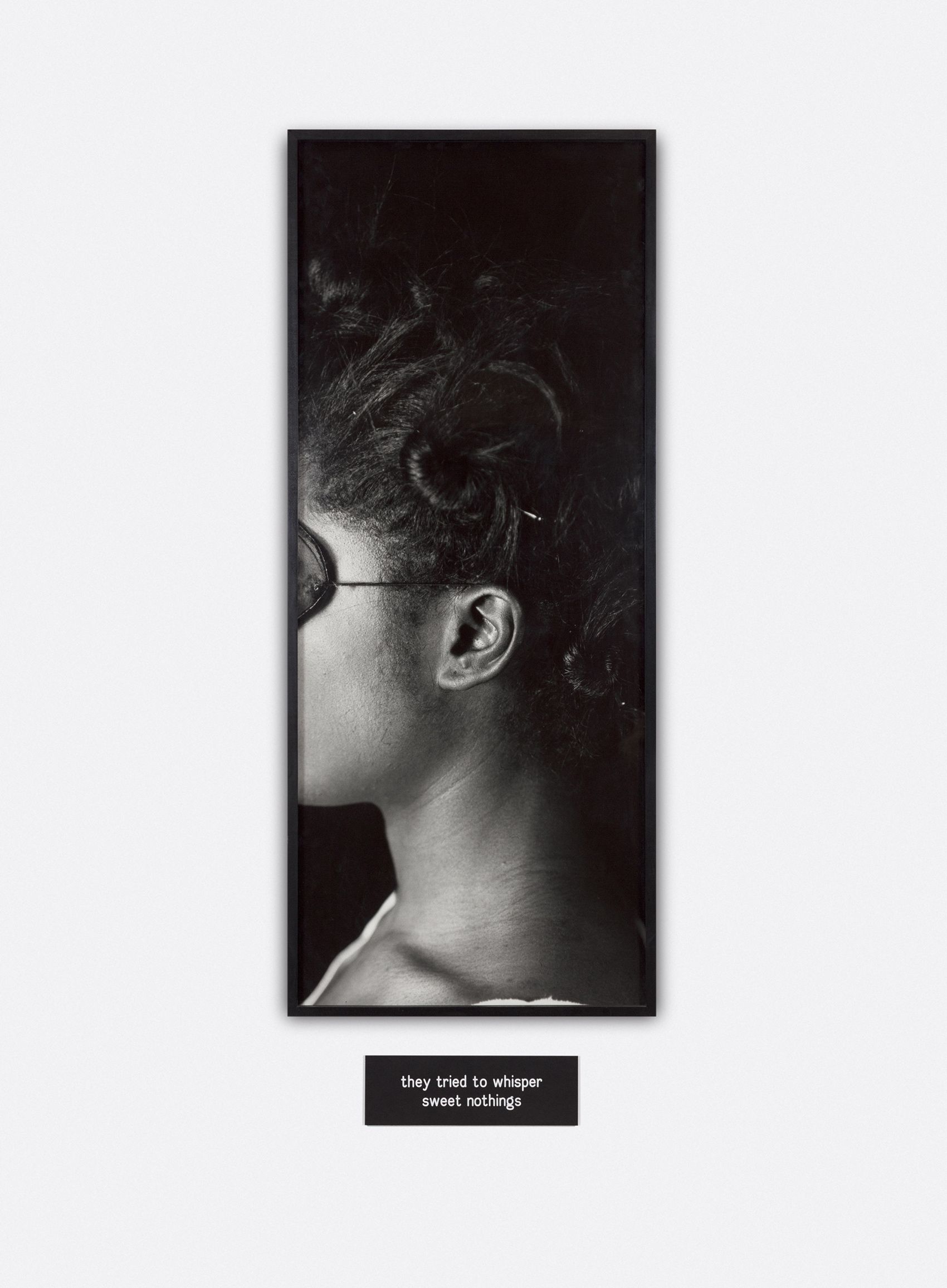
Portrait, 1988
1 silver gelatin print, 1 engraved plastic plaque - 62 x 25 in (157.5 x 63.5 cm)
-

Sounds Like, 1988
3 black and white dye diffusion Polaroid prints, ceramic letters - Overall: 73 1/2 x 25 in (186.7 x 63.5 cm)
-
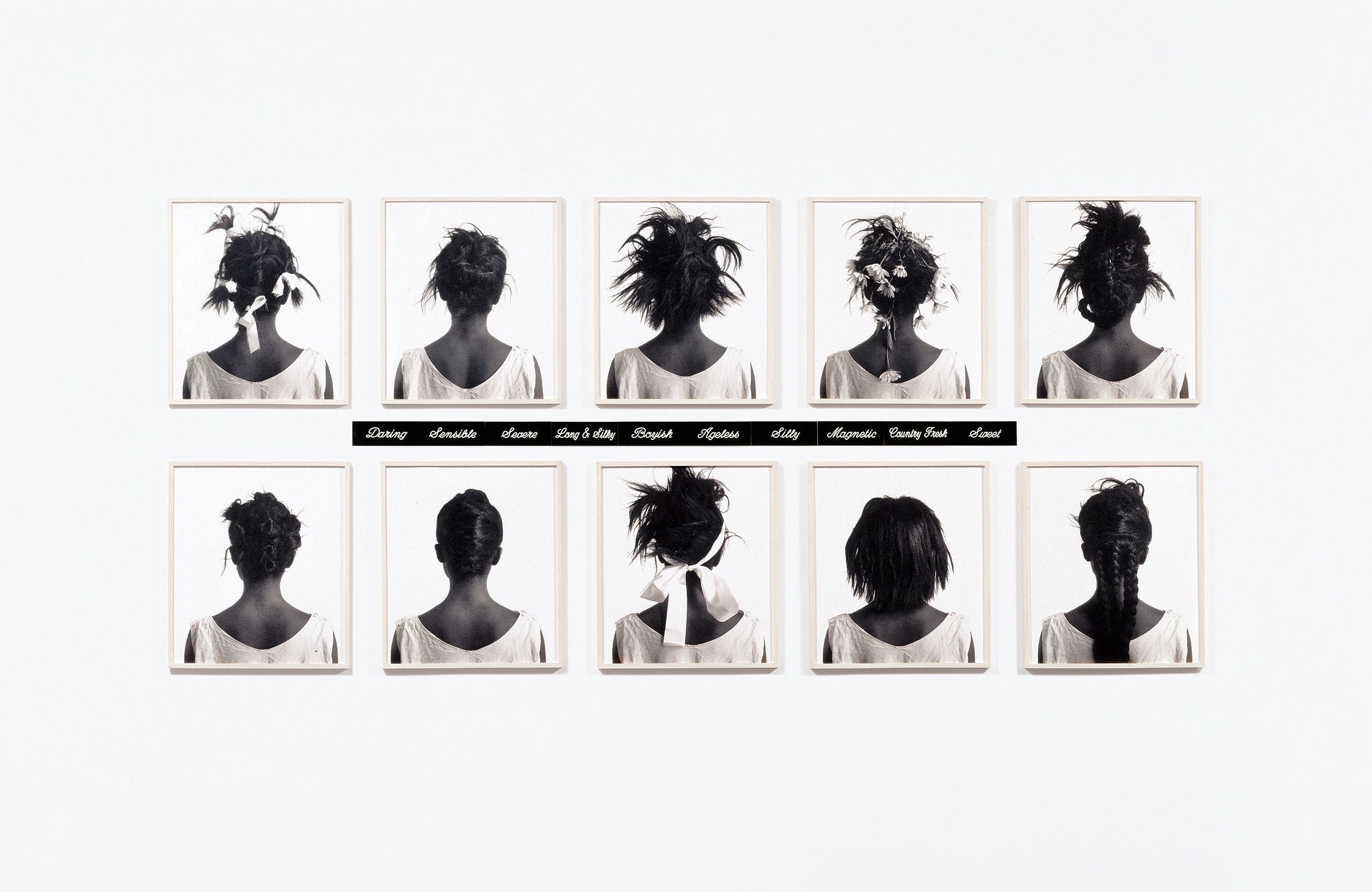
Stereo Styles, 1988
10 black and white dye diffusion Polaroid prints, 10 engraved plastic plaques - Overall: 57 3/4 x 125 1/4 x 1 3/8 in (146.7 x 318.1 x 3.5 cm), "Stereo Styles (1988) consists of ten black-and-white photos of a young black woman (once again, seen from behind) whose straightened hair is styled differently in each--from a neat bun to a loose arrangement studded with wilting daisies. They present plenty of visual information but ironically don't reveal much: neither the hairdos nor the accompanying descriptions ("Daring," "Long & Silky," "Country Fresh," "Sweet") tell us anything of importance about the pictured woman." -Bonita McLaughlin
-

Test, 1988
2 silver gelatin prints, 1 engraved plastic plaque - Overall: 66 x 39 x 2 1/2 in (167.6 x 99.1 x 6.4 cm)
-
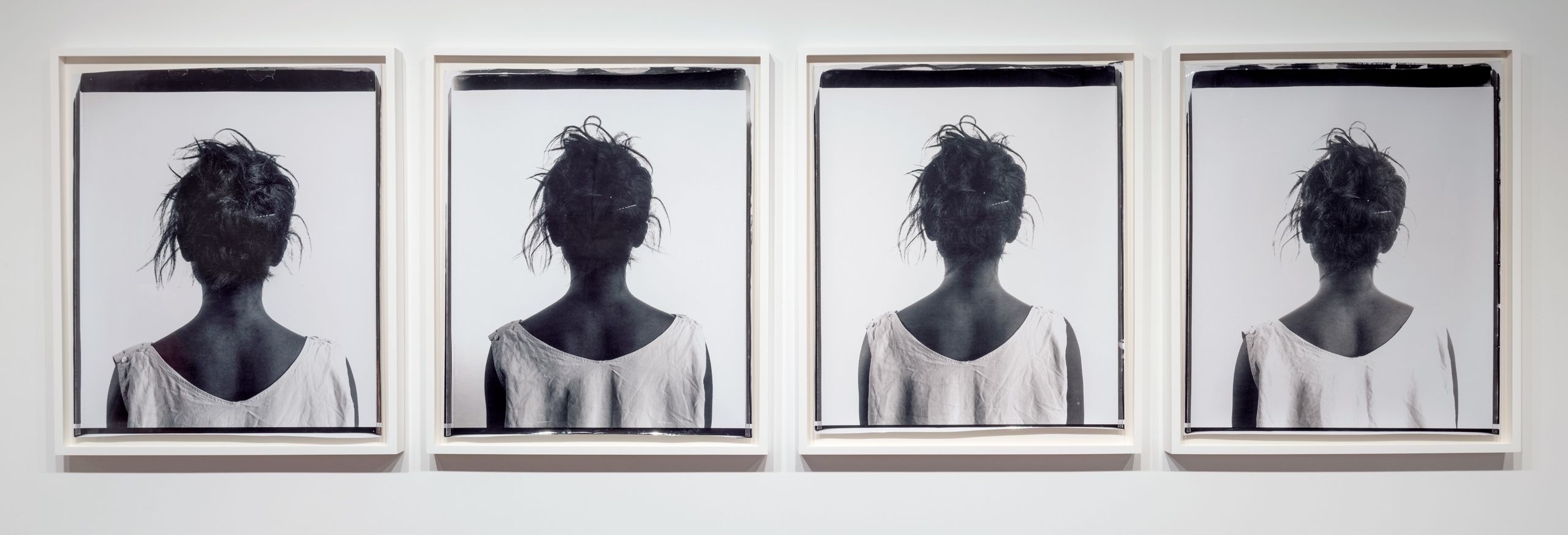
Untitled, 1988
4 black and white dye diffused Polaroid prints - Overall: 24 7/8 x 90 x 1 3/8 in (63.2 x 228.6 x 3.5 cm)
-
![4 dye diffusion color Polaroid prints, 15 engraved plastic plaques, ceramic letters - Overall: 39 x 108 1/8 x 1 5/8 in (99.1 x 274.6 x 4.1 cm), "Simpson's pieces remind us that even scientific discourse is not objective, but rather is based upon conjectural or intuitive reasoning, and can be open to several interpretations and appropriations. You're Fine, 1988, suggests that discourse surrounding AIDS now enfolds "non-scientific" issues such as racism, sexism, and homophobia within its framework. Are government and big business really protecting us by mandating that employees take drug and AIDS tests or will these tests be used to discriminate against people of color and homosexuals? Should workers allow themselves to be inspected like cattle before they are hired? These are the kinds of questions that the young woman on the medical examination table raises." -Yasmin Ramirez Harwood You're Fine, 1988]()
You're Fine, 1988
4 dye diffusion color Polaroid prints, 15 engraved plastic plaques, ceramic letters - Overall: 39 x 108 1/8 x 1 5/8 in (99.1 x 274.6 x 4.1 cm), "Simpson's pieces remind us that even scientific discourse is not objective, but rather is based upon conjectural or intuitive reasoning, and can be open to several interpretations and appropriations. You're Fine, 1988, suggests that discourse surrounding AIDS now enfolds "non-scientific" issues such as racism, sexism, and homophobia within its framework. Are government and big business really protecting us by mandating that employees take drug and AIDS tests or will these tests be used to discriminate against people of color and homosexuals? Should workers allow themselves to be inspected like cattle before they are hired? These are the kinds of questions that the young woman on the medical examination table raises." -Yasmin Ramirez Harwood
-
![Silver gelatin print, 1 engraved plastic plaque - Overall: 36 x 48 x 2 in (91.4 x 121.9 x 5.1 cm), Plaque: 10 in diameter (25.4 cm diameter), "Completing the Analogy explores the affiliations of language and power by playing with the rules of logic and making nonsense of reason. Usually analogies are guided by reciprocal relations between similar things, or by resemblance between things. In this case, the analogies disrupt inductive reasoning and interrogate the ways in which similarity is constituted. Completing the Analogy examines the coercive reasoning that institutes relations of similarity or reference. The correspondence established between objects and between word and object is achieved only at the cost of violence." -Saidiya V. Hartman Completing the Analogy, 1987]()
Completing the Analogy, 1987
Silver gelatin print, 1 engraved plastic plaque - Overall: 36 x 48 x 2 in (91.4 x 121.9 x 5.1 cm), Plaque: 10 in diameter (25.4 cm diameter), "Completing the Analogy explores the affiliations of language and power by playing with the rules of logic and making nonsense of reason. Usually analogies are guided by reciprocal relations between similar things, or by resemblance between things. In this case, the analogies disrupt inductive reasoning and interrogate the ways in which similarity is constituted. Completing the Analogy examines the coercive reasoning that institutes relations of similarity or reference. The correspondence established between objects and between word and object is achieved only at the cost of violence." -Saidiya V. Hartman
-
![4 silver gelatin prints, 3 engraved plastic plaques - Overall: 78 x 151 in (198.1 x 383.5 cm) Tricks Are For, 1987]()
Tricks Are For, 1987
4 silver gelatin prints, 3 engraved plastic plaques - Overall: 78 x 151 in (198.1 x 383.5 cm)
-
![4 silver gelatin prints, 2 engraved plastic plaques - Overall: 43 1/2 x 79 1/2 x 7/8 in (110.5 x 201.9 x .2 cm), "In Plaques, Simpson recasts a children's game with utter sobriety and reveals the instrumental fictions of the social order lodged within the rules of the game. The text is about naming, showing, and power. As the words of the game Rock, Paper, Scissors are reeled off, an order of power is instituted. Although the victor and the elements in the configuration shift, the order of power remains the same. Hierarchy is ritualized in the game. Yet what appears to be a self-evident and natural order of power to some is unfathomable to others. From the perspective of those dark and heavy-handed, "it was impossible to make sense of the natural order of things." -Saidiya V. Hartman Plaques, 1986]()
Plaques, 1986
4 silver gelatin prints, 2 engraved plastic plaques - Overall: 43 1/2 x 79 1/2 x 7/8 in (110.5 x 201.9 x .2 cm), "In Plaques, Simpson recasts a children's game with utter sobriety and reveals the instrumental fictions of the social order lodged within the rules of the game. The text is about naming, showing, and power. As the words of the game Rock, Paper, Scissors are reeled off, an order of power is instituted. Although the victor and the elements in the configuration shift, the order of power remains the same. Hierarchy is ritualized in the game. Yet what appears to be a self-evident and natural order of power to some is unfathomable to others. From the perspective of those dark and heavy-handed, "it was impossible to make sense of the natural order of things." -Saidiya V. Hartman
-
![1 wooden accordion screen, 3 silver gelatin prints, vinyl lettering - Overall: 73 1/2 x 60 x 22 in (186.7 x 152.4 x 55.9 cm), "The sequential panels are cinematic in implication not only because the story advances frame by frame but also because of the suspense implied in some between the setup on the front and the concluding phrase on the back or, in the case of a pair of related screens, by the movement from one to the other." -Joan Simon Screen 1, 1986]()
Screen 1, 1986
1 wooden accordion screen, 3 silver gelatin prints, vinyl lettering - Overall: 73 1/2 x 60 x 22 in (186.7 x 152.4 x 55.9 cm), "The sequential panels are cinematic in implication not only because the story advances frame by frame but also because of the suspense implied in some between the setup on the front and the concluding phrase on the back or, in the case of a pair of related screens, by the movement from one to the other." -Joan Simon
-
![Screen 1, 1986 (reverse)]()
Screen 1, 1986 (reverse)
-
![1 wooden accordion screen, 3 silver gelatin prints, vinyl lettering - Overall: 73 1/2 x 60 x 22 in (186.7 x 152.4 x 55.9 cm) Screen 2, 1986]()
Screen 2, 1986
1 wooden accordion screen, 3 silver gelatin prints, vinyl lettering - Overall: 73 1/2 x 60 x 22 in (186.7 x 152.4 x 55.9 cm)
-
![1 wooden accordion screen, 3 silver gelatin prints, vinyl lettering - Overall: 73 1/2 x 60 x 22 in (186.7 x 152.4 x 55.9 cm) Screen 3, 1986]()
Screen 3, 1986
1 wooden accordion screen, 3 silver gelatin prints, vinyl lettering - Overall: 73 1/2 x 60 x 22 in (186.7 x 152.4 x 55.9 cm)
-
![1 wooden accordion screen, 3 silver gelatin prints, vinyl lettering - Overall: 73 1/2 x 60 x 22 in (186.7 x 152.4 x 55.9 cm), "In works such as Screen 4 (1986), a freestanding screen whose three panels bear black-and-white photographs of a standing woman, Simpson calls attention to the emphasis on sexuality so often found in representations of black women by simply omitting it. Standing with arms crossed, or at her sides, or on her hips, and wearing the ubiquitous white shift, here baggy and wrinkled, Simpson's model chooses neither to please nor attract. The gap between her reality and the desire for pleasure inherent in the male gaze is also alluded to in the words inscribed on one of the panels: "She was no more exotic than the sparse room she posed in."" -Bonita McLaughlin Screen 4, 1986]()
Screen 4, 1986
1 wooden accordion screen, 3 silver gelatin prints, vinyl lettering - Overall: 73 1/2 x 60 x 22 in (186.7 x 152.4 x 55.9 cm), "In works such as Screen 4 (1986), a freestanding screen whose three panels bear black-and-white photographs of a standing woman, Simpson calls attention to the emphasis on sexuality so often found in representations of black women by simply omitting it. Standing with arms crossed, or at her sides, or on her hips, and wearing the ubiquitous white shift, here baggy and wrinkled, Simpson's model chooses neither to please nor attract. The gap between her reality and the desire for pleasure inherent in the male gaze is also alluded to in the words inscribed on one of the panels: "She was no more exotic than the sparse room she posed in."" -Bonita McLaughlin
-
![4 silver gelatin prints, 6 engraved plastic plaques - Overall: 39 1/2 x 106 1/2 x 3/8 in (83.8 x 264.8 x 1 cm), "These phrases would be of little help in determining the identity of a particular person, for each is abstracted as the image of the woman seen from the back. The work's lack of specificity, as well as its incompleteness, sets the ground for speculation." -Joan Simon Twenty Questions, 1986]()
Twenty Questions, 1986
4 silver gelatin prints, 6 engraved plastic plaques - Overall: 39 1/2 x 106 1/2 x 3/8 in (83.8 x 264.8 x 1 cm), "These phrases would be of little help in determining the identity of a particular person, for each is abstracted as the image of the woman seen from the back. The work's lack of specificity, as well as its incompleteness, sets the ground for speculation." -Joan Simon
-
![Silver gelatin print, vinyl lettering - Overall: 59 x 80 x 2 1/2 in (149.9 x 203.2 x 6.4 cm), "What Lorna does is confound our standard notion of looking by giving us a subject whose absent face is distinctly there, as in the Negro presence in the history of art, rarely acknowledged, rarely felt. These pieces are about colored anxiety filling the room of one's consciousness." -Hilton Als Waterbearer, 1986]()
Waterbearer, 1986
Silver gelatin print, vinyl lettering - Overall: 59 x 80 x 2 1/2 in (149.9 x 203.2 x 6.4 cm), "What Lorna does is confound our standard notion of looking by giving us a subject whose absent face is distinctly there, as in the Negro presence in the history of art, rarely acknowledged, rarely felt. These pieces are about colored anxiety filling the room of one's consciousness." -Hilton Als
-
![6 silver gelatin prints, 7 engraved text plaques - Overall: 76 1/2 x 278 1/4 x 2 in (194.3 x 706.8 x 5.1 cm), "The title of her first photo-text work, made in 1985, and of the exhibition of that year in which it was first exhibited was Gestures / Reenactments, and one can argue that all Simpson's work is built on the juxtaposition of gestures and reenactments, creating meaning in the resonant gap between the two. It is a gap that invites the viewer/reader to enter, all the while requiring an active reckoning with some inalienable truths: seeing is not necessarily believing, and what we might see is altered not only by our individual experiences and assumptions but also, critically, by what we might hear." -Joan Simon Gestures and Reenactments, 1985]()
Gestures and Reenactments, 1985
6 silver gelatin prints, 7 engraved text plaques - Overall: 76 1/2 x 278 1/4 x 2 in (194.3 x 706.8 x 5.1 cm), "The title of her first photo-text work, made in 1985, and of the exhibition of that year in which it was first exhibited was Gestures / Reenactments, and one can argue that all Simpson's work is built on the juxtaposition of gestures and reenactments, creating meaning in the resonant gap between the two. It is a gap that invites the viewer/reader to enter, all the while requiring an active reckoning with some inalienable truths: seeing is not necessarily believing, and what we might see is altered not only by our individual experiences and assumptions but also, critically, by what we might hear." -Joan Simon
